The serene and calculating Swedish tennis master, Björn Borg, has subtly amassed a fortune that is comparable to his sporting accomplishments. With an estimated net worth of $80 million today, Borg’s path to riches started with perseverance as much as trophies. Elite athletes who have reinvented themselves with noticeably better entrepreneurial instincts have a trajectory that is remarkably similar to his. By using his name and image, Borg established a brand identity that is still remarkably effective decades after his retirement, while others faded.
In 1979, he became the first player to earn $1 million from tournaments in a single year. That amount, when adjusted for inflation, is currently about $4 million, demonstrating the significant financial impact of his domination. However, outside of the courts, his fashion brand, appropriately named “Björn Borg,” rose to prominence in the lifestyle clothing market, especially in Scandinavia. The brand’s strong 2020 revenue of SEK 705.2 million highlights how effective Borg’s off-court strategy was.
| Attribute | Information |
|---|---|
| Full Name | Björn Rune Borg |
| Date of Birth | June 6, 1956 |
| Birthplace | Stockholm, Sweden |
| Residence | Monaco, Sweden (Värmdö estate) |
| Height | 1.80 m (5 ft 11 in) |
| Net Worth (2025) | $80 million |
| Prize Money (Career) | $3,655,751 (≈$20 million adjusted) |
| Grand Slam Titles | 11 (6 French Open, 5 Wimbledon) |
| Inducted to Hall of Fame | 1987 |
| Brand Revenue (2020) | SEK 705.2 million |
| Marriages | Mariana Simionescu, Loredana Bertè, Patricia Ostfeld |
| Children | Robin, Leo |
| Source | Wikipedia |
In addition to defining an era, his intense rivalry with John McEnroe increased tennis’s commercial potential. Their 1980 Wimbledon final was more than just a match; it was a demonstration of their tenacity, style, and unwavering resolve. This incident, which was captured in the 2017 movie “Borg vs. McEnroe,” demonstrated the mental contrast between two men: one was extremely loud, while the other was incredibly calm. Their relationship is still one of the most talked about and emotionally charged rivalries in sports, even after several decades.

Borg had a difficult time after retirement. Following unsuccessful business endeavors, he almost went bankrupt, mirroring the difficulties faced by many athletes making the switch from sport to business. But his comeback was especially creative. In 2006, he sold World Brand Management the lifetime rights to his brand name for $18 million, which was a wise gamble for Borg and surprisingly inexpensive for the company. It gave him new focus and long-term financial stability.
Borg has demonstrated remarkable versatility in maintaining the financial viability of his legacy. Borg built a lifestyle empire, in contrast to many of his peers whose identity after retirement depends only on commentary work or occasional appearances. Since then, the brand has spread throughout different areas, and its success can be attributed to its enduring appeal and consistent branding.
While many brands suffered during the pandemic, Borg’s company remained remarkably resilient. His enduring reputation and contemporary marketing techniques made sure the label remained visible. His son, Leo Borg, joined the professional tennis circuit, providing a poetic continuation of his legacy, while his personal story continued to develop.
Beyond his trophy cabinet or apparel line, Borg’s journey has a significant social impact. He represented a time of focused excellence, but more significantly, his financial development offered a powerful example for contemporary athletes: embrace brand identity, diversify early, and don’t undervalue the importance of long-term planning. In a sense, Borg created his own mythology by transforming nostalgia into money and serenity into wealth.
Borg made sure his name wasn’t stuck in the past by working with executive talent and constantly tying the brand to youthful energy. Rather, it quietly but assuredly transformed into a declaration of timeless cool and athletic sophistication. His good fortune is no accident. It’s the outcome of astute choices, a remarkably strong capacity for adaptation, and brand consistency. Borg manages to maintain his status as a modern force and a historical symbol with remarkable ease, whereas many other celebrities struggle to stay relevant.
Björn Borg’s financial story reads more like a masterclass in reinvention than a conventional sports biography thanks to clever licensing, strategic partnerships, and a deep-seated personal ethos of excellence. His example is especially helpful for aspiring athletes, business owners, and brand-builders—a calm strategy with remarkably obvious results.


